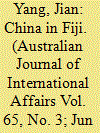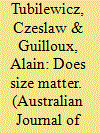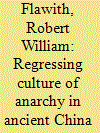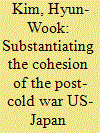|
|
|
Sort Order |
|
|
|
Items / Page
|
|
|
|
|
|
|
| Srl | Item |
| 1 |
ID:
104987


|
|
|
|
|
| Publication |
2011.
|
| Summary/Abstract |
A widely held perception in Oceania is that China has taken the opportunity of Western sanctions against Fiji's military-led regime to expand its influence in Fiji. Observers and media in the region were alarmed by the sudden increase of China's pledged aid to Fiji shortly after the 2006 military takeover. They are concerned that China has a well-calculated strategy of displacing traditional Western players in Fiji, most notably Australia and New Zealand. Such concern is not well founded. While China does have multiple interests, including strategic interests, in Fiji, there is no clear evidence to suggest that China aims to displace the traditional players there. China's growing influence in Fiji is part of China's global rise. Both Australia and New Zealand are committed to Fiji and the South Pacific as a whole. Given its substantial interests in Australia and New Zealand, it is not in China's interest to increase its influence in Fiji at the cost of its relations with these two traditional players.
|
|
|
|
|
|
|
|
|
|
|
|
|
|
|
|
| 2 |
ID:
104988


|
|
|
|
|
| Publication |
2011.
|
| Summary/Abstract |
This article is the first systematic attempt at estimating the size of Taiwanese foreign aid and, thus, the cost of Taiwan's aid diplomacy. It questions the Republic of China (ROC) President Ma Ying-jeou's justification of his 'diplomatic truce' with China as necessitated by an ineffectiveness of his predecessor Chen Shui-bian's costly aid diplomacy. Deriving its evidence from the ROC governmental budgets, local media reports and interviews with Taiwanese officials involved in foreign aid implementation, the article argues that President Chen did not engage in 'generous financial aid' and proposes that this parsimony, rather than futility of aid diplomacy as a strategy to expand Taiwan's international space, should be considered as contributing to Taipei's diplomatic failures from 2000 to 2008.
|
|
|
|
|
|
|
|
|
|
|
|
|
|
|
|
| 3 |
ID:
104985


|
|
|
|
|
| Publication |
2011.
|
| Summary/Abstract |
What does the qualitative increase in the brutality of international relations in the Eastern Zhou period of ancient China (770-221bc) mean for the implicit progressivism of Alexander Wendt's constructivism, as espoused in his landmark text Social Theory of International Politics (1999)? Wendt's constructivism is useful in understanding international systems outside the contemporary Westphalian order and provides an excellent analytical tool for understanding ancient China. However, this article argues that Wendt's implicit teleology of progressively cooperative 'cultures of anarchy' in international politics is empirically questionable. It is demonstrated that such a progression is not supported by the historical evidence of ancient China, which represents an instance of an international system 'regressing' from a more to a less cooperative international social structure.
|
|
|
|
|
|
|
|
|
|
|
|
|
|
|
|
| 4 |
ID:
104986


|
|
|
|
|
| Publication |
2011.
|
| Summary/Abstract |
Since 2005, a burgeoning wave of Chinese investments has set off a new 'minerals boom' in the Australian iron ore and coal mining sectors. While normally a welcome development, the state-owned and strategic nature of the investors has raised concerns in Australia about how these should be regulated. As a result, in February 2008 the Australian government declared an intention to more closely screen foreign direct investment (FDI) from state-owned sources, which both supporters and detractors alike have claimed is evidence of 'resource nationalism' in Australia's approach towards its trade and investment relationships with China. This article challenges this understanding through an examination of the characteristics of Chinese mining FDI, the dilemmas these present to the Australian government, and the relatively restrained nature of its response. Through this, Australia's FDI policy is explained as a defensive move against the potential for strategic behaviour by Chinese investors resulting from their state ownership, rather than any national program to subject minerals trade and investment to political control. On this basis, the article argues that Australian government policy instead evidences a 'resource liberalism' approach, which intends to ensure that the governance of Australia's minerals trade and investment with China remain market-based processes.
|
|
|
|
|
|
|
|
|
|
|
|
|
|
|
|
| 5 |
ID:
104989


|
|
|
|
|
| Publication |
2011.
|
| Summary/Abstract |
Notwithstanding current disarray, the post-cold war US-Japan alliance has enjoyed its most cohesive status in its history. Japan altered its passive cold war alliance policy and became a more active and equal partner with the United States. Even though there exist many explanations of what has caused this cohesiveness, there is hardly any attempt to substantiate the level of alliance cohesion itself. The purpose of this essay is to demonstrate the cohesion of this alliance by employing concrete operational indicators: homogeneity in goals, threat perception, strategic compatibility and command structure. By investigating how these operational indicators have changed over time, the author proves substantially that the post-cold war US-Japan alliance has developed more cohesively.
|
|
|
|
|
|
|
|
|
|
|
|
|
|
|
|
|
|
|
|
|